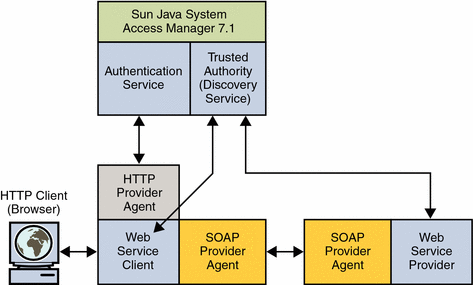SOAP Authentication Agent
The SOAP authentication agent secures SOAP messages between a WSC and a WSP. The agent can be configured for use as an authentication provider on either the WSC server or the WSP server. This initial release encapsulates the Liberty Identity Web Services Framework (Liberty ID-WSF) SOAP Binding Specification as implemented by Access Manager and supports the following:
Note –
The configuration process for the SOAP authentication agent is described in Installing the Policy Agent 2.2 for Sun Java System Application Server 9.0 / Web Services.
Supported Liberty Alliance Project Security Tokens
In a scenario where security is enabled using Liberty Alliance Project tokens, the HTTP client requests (via the WSC) access to a service. The HTTP authentication agent redirects the request to the Access Manager Authentication Service for authentication and to determine the security mechanism registered by the WSP and obtain the security tokens expected. After a successful authentication, the WSC provides a SOAP body while the SOAP authentication agent on the WSC side inserts the security header and a token. The message is then signed before the request is sent to the WSP.
When received by the SOAP authentication agent on the WSP side, the signature and security token in the SOAP request are verified before forwarding the request on to the WSP itself. The WSP then processes it and returns a response, signed by the SOAP authentication agent on the WSP side, back to the WSC. The SOAP authentication agent on the WSC side then verifies the signature before forwarding the response on to the WSC. The following diagram illustrates the interactions as described.

The following Liberty Alliance Project security tokens are supported in this release:
- X.509
-
A secure web service uses a PKI (public key infrastructure) in which the web service consumer supplies a public key as the means for identifying the requester and accomplishing authentication with the web service provider. Authentication with the web service provider using processing rules defined by the Liberty Alliance Project.
- BearerToken
-
A secure web service uses the Security Assertion Markup Language (SAML) SAML Bearer token confirmation method. The web service consumer supplies a SAML assertion with public key information as the means for authenticating the requester to the web service provider. A second signature binds the assertion to the SOAP message This is accomplished using processing rules defined by the Liberty Alliance Project
- SAMLToken
-
A secure web service uses the SAML holder-of-key confirmation method. The web service consumer adds a SAML assertion and a digital signature to a SOAP header. A sender certificate or public key is also provided with the signature. This is accomplished using processing rules defined by the Liberty Alliance Project.
Supported Web Services-Interoperability Basic Security Profile Security Tokens
In a scenario where security is enabled using Web Services-Interoperability Basic Security Profile (WS-I BSP) tokens, the HTTP client requests (via the WSC) access to a service. The SOAP authentication agent redirects the request to the Access Manager Authentication Service for authentication and to determine the security mechanism registered by the WSP and obtain the expected security tokens. After a successful authentication, the WSC provides a SOAP body while the SOAP authentication agent on the WSC side inserts the security header and a token. The message is then signed before the request is sent to the WSP.
When received by the SOAP authentication agent on the WSP side, the signature and security token in the SOAP request are verified before forwarding the request on to the WSP itself. The WSP then processes it and returns a response, signed by the SOAP authentication agent on the WSP side, back to the WSC. The SOAP authentication agent on the WSC side then verifies the signature before forwarding the response on to the WSC. The following diagram illustrates the interactions as described.

The following WS-I BSP security tokens are supported in this release.
- User Name
-
A secure web service requires a user name, password and, optionally, a signed the request. The web service consumer supplies a username token as the means for identifying the requester and a password, shared secret, or password equivalent to authenticate the identity to the web service provider.
- X.509
-
A secure web service uses a PKI (public key infrastructure) in which the web service consumer supplies a public key as the means for identifying the requester and accomplishing authentication with to the web service provider.
- SAML-Holder-Of-Key
-
A secure web service uses the SAML holder-of-key confirmation method. The web service consumer supplies a SAML assertion with public key information as the means for authenticating the requester to the web service provider. A second signature binds the assertion to the SOAP payload.
- SAML-SenderVouches
-
A secure web service uses the SAML sender-vouches confirmation method. The web service consumer adds a SAML assertion and a digital signature to a SOAP header. A sender certificate or public key is also provided with the signature.
- © 2010, Oracle Corporation and/or its affiliates
